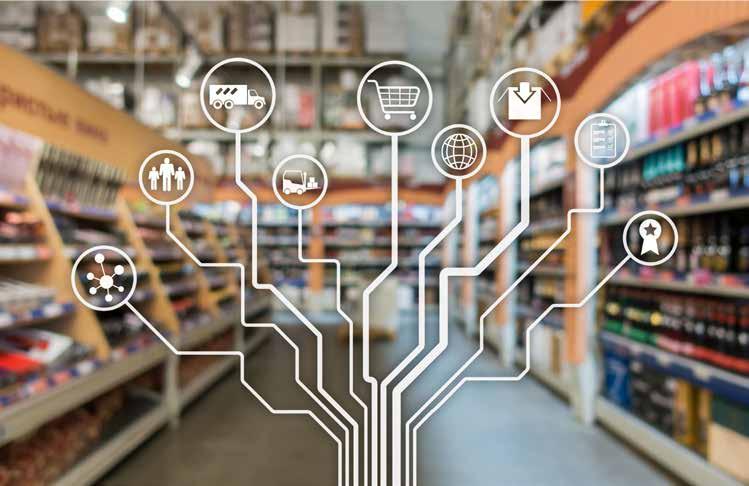
4 minute read
Violence and organised crime up: annual retail security survey
The 2022 edition of the National Retail Federation’s Retail Security Survey indicates more and more retailers in the US are turning to smart tech to reign in $100 billion worth of losses
One rapidly ballooning issue is retail shrink, a nearly $100 billion problem for the industry, according to the National Retail Federation’s (NRF) 2022 National Retail Security Survey (NRSS).
The National Retail Federation’s Retail Security Survey is an annual survey of retail loss prevention professionals that covers retail security issues such as inventory shrink, employee integrity and organised retail crime (ORC). This year’s report includes a closer look at the impact of ORC on the retail industry.
Overall, the study found that – consistent with the last five years – the average shrink rate in 2021 was 1.4%. When taken as a percentage of total retail sales, the shrink represents $94.5 billion in losses, up from $90.8 billion in 2020.
Responses indicated that retail shrink is primarily driven by external theft (37%), including theft attributed to ORC, with employee/internal theft accounting for 28.5%.. Retailers, on average, saw a 26.5% increase in ORC incidents in 2021.
Violence Eight in 10 retailers surveyed reported that the violence and aggression associated with ORC incidents increased in the past year. Over half reported that mass violence and gun violence had also risen in recent years.
Labour shortages, challenges with employee retention and hiring, and issues related to enforcing COVID precautions, contributed to the risks of violence and hostility. The climate in the US of active assailants and gun violence added to retailers’ concerns around keeping employees and customers safe.
The majority of those surveyed (81.2%) reported that ORC offenders are “somewhat more” or “much more” violent when compared to just one year ago. Over one third (35.9%) reported that ORC offenders were “much more” violent when compared with one year ago.
COVID-19 COVID-19 has had profound implications for the retail risk landscape, not least in relation to security. A staggering 89.7% of respondents, for example, reported that COVID-19 had resulted in an increase in the risk of violence within their organisation.
The majority of respondents also reported that overall risk had increased since COVID-19, as well as the risk of shoplifting, ORC and employee theft. In contrast, 60.1% of respondents said that COVID-19 had no impact on cargo theft risk at their organisation.
Other areas where respondents reported that the COVID-19 pandemic had impacted their risk included: (1) labour-related challenges; (2) increased violence and hostility; (3) and issues related to masking and maintaining COVID-19 precautions.
Labour shortages and turnover have had significant effects on retailers,

including serious implications for loss prevention. “Retailers may not have sufficient employees in the store to provide informal guardianship, that is, to simply deter retail crimes with their presence,” stated the report.
“Employee turnover can also reduce retailers’ ability to maintain trained staff and develop their workforce – for example, if an employee develops experience controlling loss and mitigating risks within a store and then leaves, the retailer must then train another employee to do so.”
Technologies Retailers are allocating significant resources to prevent the victimisation of their employees, customers and organisations. Almost one third of retailers surveyed have established a dedicated ORC team, and those that have tend to record more apprehensions and prosecutions.
Many have boosted their budgets for loss prevention and technology. 52.4% increasing their budgets specifically for capital and equipment, including such technological solutions as artificial intelligence-based video analytics at self-checkouts, self-service locking cases, autonomous security robots and licence plate recognition.
With increasingly sophisticated risks, retailers are turning to new strategies and technologies. Retailers reported that they were implementing or planning to implement such systems as RFID (38.6%); AI-based pointof-sale (POS)/self-checkout (SCO) video analytics (29.8%); License plate recognition (19.3%); and/or self-service locking cases or lockers (17.5%), AIbased perimeter surveillance (14%); advanced weapon detection (12.3%); facial recognition (12.3%).
“RFID has many uses throughout retail, from managing and tracking inventory in the supply chain to maintaining up-to-date in-store inventory records, or identifying and recovering stolen products,” stated the report. “AI-based POS/SCO video analytics can help detect crimes such as ticket- or product-switching, or sweethearting.”
“Ticket- and product-switching involves retail offenders using the barcode from a less expensive item in place of the barcode for a more expensive item while scanning products, while sweet hearting includes a variety of offenses at the POS involving an employee and a “sweetheart” – someone to whom they are giving “favourable” treatment.”
According to the report, many of the technologies that retailers are implementing are designed to provide greater threat awareness. “For example, licence plate recognition systems, perimeter surveillance, facial recognition and multi-sensor parking lot surveillance towers/units can all help retailers detect when a potential threat has arrived on the premises, as well as gather information about suspects who entered/exited the store and/or the parking lot.”
In addition to the tech investment, the majority of respondents reported needing greater analytic and investigative skills.
Interestingly, the report indicated that retailers are wanting stronger ORC legislation, as well as better law enforcement, increased penalties for theft, and a reduction in crime thresholds. 70.8% of respondents reported increases in ORC in areas where crime thresholds had been increased.









